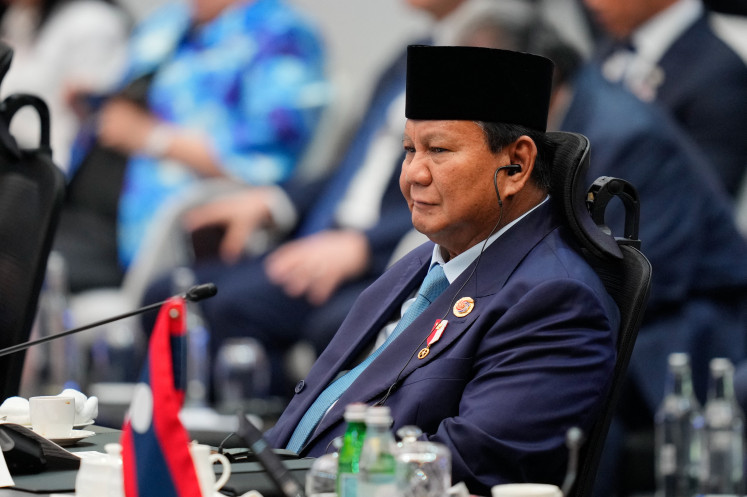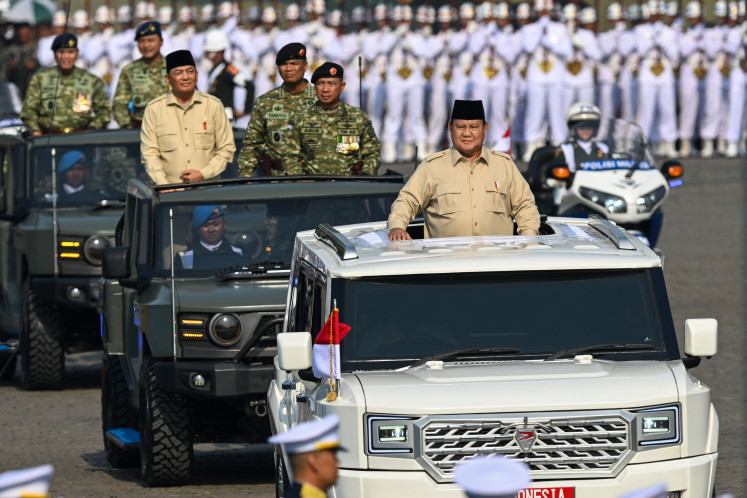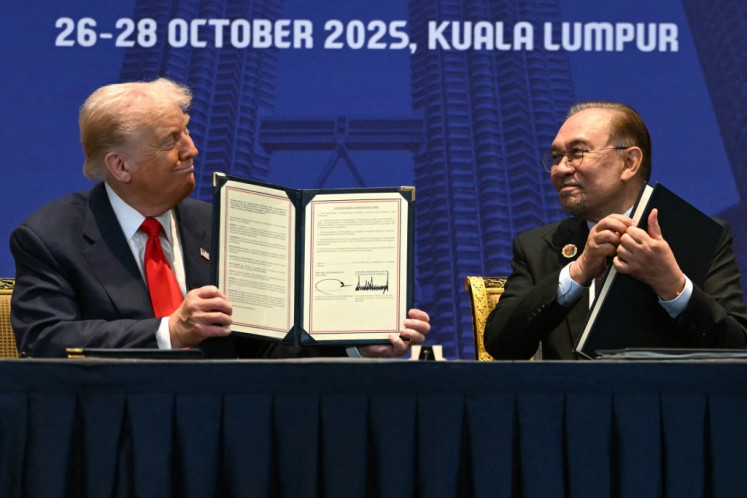Popular Reads
Top Results
Can't find what you're looking for?
View all search resultsPopular Reads
Top Results
Can't find what you're looking for?
View all search resultsPalembang displays world's largest Koran
The big book: A version of the Koran, hand-carved onto sheets of wood, is said to be the largest in the world
Change text size
Gift Premium Articles
to Anyone
The big book: A version of the Koran, hand-carved onto sheets of wood, is said to be the largest in the world.(JP/Khairul Saleh)
Versions of the Islamic holy book, the Koran, have been discovered in different styles and from different eras, but a wooden version believed to be the largest in the world is found only in Palembang, South Sumatra.
Indonesian Muslims, particularly those in South Sumatra, take pride in this monumental work, a giant scripture carved out by trained, skillful and meticulous hands over six years. This unique book is known as Al Akbar (the Great).
To create the masterpiece, no less than 50 cubic meters of tembesu wood (Fragrea fragrans) from across the province were used. The timber was cut into 315 planks for the carved pages - each 177 centimeters tall, 140 centimeters wide and 2.5 centimeters thick - with their dark color forming an attractive background for the golden Arabic characters.
The wooden Koran was crafted in a pesantren or Islamic boarding school in Tangga Buntung in Palembang's 32-Ilir subdistrict, Palembang. The other Muslim scripture with the title of "largest" is made of paper, making this distinctive treasure special to Palembang.
During its monthlong public display on the third floor of Palembang's grand mosque, beginning in mid-May, hundreds of people gathered to take a close look at the 30-section holy book. As well as giving people a chance to see the completed carvings, the exhibition also invited anyone to make corrections in the case of any errors.
This, said 36-year-old Syofwatillah Mozaib Zaini, who initiated the undertaking, is because, despite previous corrections by some clerics, there could still be some slips to be straightened out in its handwritten text or its recital marks.
To help discover any errors, the exhibition committee offered the carvings in two phases: sections 1-15 were open for public proposals from May 14 to 24, and sections 16-30 from May 25 to June 5.
"Alhamdulillah *praise be to God*, so far no such oversight has been found," Syofwatillah said during the first phase.
"Let's hope no mistakes are discovered, thus making it the same as the correct volumes of the Koran now available."
As scheduled, this great book will be officially shown to the public by President Susilo Bambang Yudhoyono in June after its final touches.
Haji Sofyan, 54, a noted Islamic instructor from Ogan Ilir regency, expressed his admiration and pride in witnessing the rare masterpiece of South Sumatra's best craftspeople.
"It's hard to imagine," said Sofyan, who visited the mosque with his group to scrutinize Al Akbar. "The process was not simple and a high degree of accuracy was demanded, because even a slight mistake can have a different meaning."
Making the giant Koran cost Rp 1.2 billion, with funds coming from individual donors and sympathizers, institutions, officials and figures such as President Susilo Bambang Yudhoyono, former South Sumatra governor Syahrial Oesman, South Sumatra Governor Alex Noerdin, Taufik Kiemas, Nazarudin Kiemas, Husni (ex-mayor of Palembang), Ishak Mekki (regent of Ogan Komering Ilir) and Rosihan Arsyad (ex-governor of South Sumatra).
The project began when a large piece of Koran woodcarving was put on display in 2000. Taufik Kiemas, who was present in the event, expressed his desire to assist the effort to continue. Finally, a team was formed for the wooden Koran project and 20 sections were finished. The crafting of the final 10 sections was initially hampered by a lack of funds, but with time and perseverance, the whole project was completed.
Overall, it was not, as has been noted, an easy process, with difficulties ranging from the slow disbursement of funds to the intricate process of handwriting and carving.
"Moreover, tembesu wood was getting scarce, with its price soaring every year, causing the costs to swell," said Taufik. "But the team decided not to raise the project's budget to avoid unnecessary suspicion."
Carried out with sincerity and patience to prove that the wooden scripture carving relied on God's blessing rather than out of a desire for profits or popularity, the project was eventually accomplished at the end of December 2008, but its launch was delayed until mid-May because of this year's elections.
Given the monumental nature of this religious work of art, Syofwatillah suggested that the wooden holy book be kept in a special museum.
"For its maintenance, security and visitors' convenience, it should belong to a special museum, but for the moment it is kept here *in the grand mosque*. We're looking for ways to make that happen," he added.
At least 40 carpenters and woodcarvers from Palembang were engaged in the delicate job of crafting the divine verses that are the basis of the faith of Muslims all over the globe.
"The workers also had to keep themselves clean through ritual washing," Syofwatillah said.
"They were dealing with the holy book rather than with ordinary items. Handwriting designs on paper were examined by Koran experts, as were the carving process and its results."










